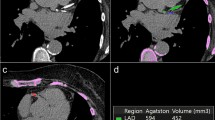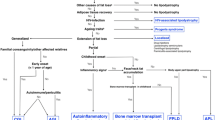Abstract
Background Visceral adipose tissue plays a central role in the development of metabolic syndrome (MS). Our study aimed to determine a relationship between MS and subepicardial adipose tissue (SAT), a component of visceral fat surrounding the heart and coronary vessels. Methods A total of 123 patients (54 ± 10 years of age, 47 male patients) diagnosed with MS and 123 age- and gender-matched control subjects were evaluated echocardiographically. Thickness of the SAT was measured using M-mode echocardiography in parasternal long and short axis views. Maximum values at any site were measured, and the average value was used for statistical analyses. Metabolic syndrome was identified according to the latest criteria of International Diabetes Federation. Results The patients with MS had significantly higher SAT thickness compared to the subjects in the control group (5.1 ± 1.7 vs. 3.4 ± 1.6 mm, P < 0.001). A stepwise increase was noted in the SAT thickness depending on the number of the MS components (P < 0.001). The multivariate stepwise linear regression analysis revealed that the diagnosis of MS (t = 3.019, P = 0.001), serum triglyceride level (t = 3.423, P = 0.001), gender (t = −5.507, P < 0.001), age (t = 2.394, P = 0.02) and waist circumference (t = 9.656, P < 0.001) were the independent determinants of SAT thickness. For each 10 and 20-cm increase in waist circumference, 0.094 and 0.19-mm increases in SAT thickness were expected. As an optimal cut off point, 4.35 mm SAT thickness have determined metabolic syndrome with a 61.7% sensitivity and 79.2% specificity. Conclusions A close relationship between SAT thickness and MS was demonstrated. Assessment of SAT thickness in routine echocardiographic examinations might be used in predicting the existence of MS and its associated cardiovascular risks.



Similar content being viewed by others
References
Haffner SM (2006) The metabolic syndrome: inflammation, diabetes mellitus, and cardiovascular disease. Am J Cardiol 97(suppl):3A–11A
Reilly MP, Rader DJ (2003) The metabolic syndrome. More than the sum of its parts? Circulation 108:1546–1551
Carr DB, Utzschneider KM, Hull RL et al (2004) Intra-abdominal fat is a major determinant of the National Cholesterol Education Program Adult Treatment Panel III criteria for the metabolic syndrome. Diabetes 53:2087–2094
Liao Y, Kwon S, Shaughnessy S et al (2004) Critical evaluation of adult treatment panel III criteria in identifying insulin resistance with dyslipidemia. Diabetes Care 27:978–983
Aldhahi W, Hamdy O (2003) Adipokines, inflammation, and the endothelium in diabetes. Curr Diab Rep 3:293–298
Funahashi T, Nakamura T, Shimomura I et al (1999) Role of adipocytokines on the pathogenesis of atherosclerosis in visceral obesity. Int Med 38:202–206
Garg A (2004) Regional adiposity and insulin resistance. J Clin Endocrinol Metab 89:4206–4210
Raji A, Seely EW, Arky RA, Simonson DC (2001) Body fat distribution and insulin resistance in healthy Asian Indians and Caucasians. J Clin Endocrinol Metab 86:5366–5371
Goodpaster BH, Thaete FL, Simoneau JA, Kelley DE (1997) Subcutaneous abdominal fat and thigh muscle composition predict insulin sensitivity independent of visceral fat. Diabetes 46:1579–1585
Kelley DE, Thaete FL, Troost F, Huwe T, Goodpaster BH (2000) Subdivisions of subcutaneous abdominal adipose tissue and insulin resistance. Am J Physiol Endocrinol Metab 278:E941–E948
Iacobellis G, Ribaudo MC, Assael F et al (2003) Echocardiographic epicardial adipose tissue is related to anthropometric and clinical parameters of metabolic syndrome: a new indicator of cardiovascular risk. J Clin Endocrinol Metab 88:5163–5168
Iacobellis G, Assael F, Ribaudo MC et al (2003) Epicardial fat from echocardiography: a new method for visceral adipose tissue prediction. Obes Res 2:304–310
Alberti KG, Zimmet P, Shaw J, IDF Epidemiology Task Force Consensus Group (2005) The metabolic syndrome––a new worldwide definition. Lancet 366:1059–1062
Chaowalit N, Somers VK, Pellikka PA, Rihal CS, Lopez-Jimenez F (2006) Subepicardial adipose tissue and the presence and severity of coronary artery disease. Atherosclerosis 186:354–359
Marchington JM, Mattacks CA, Pond CM (1989) Adipose tissue in the mammalian heart and pericardium: structure, foetal development and biochemical properties. Comp Biochem Physiol B94:225–232
Iacobellis G, Leonetti F (2005) Epicardial adipose tissue and insulin resistance in obese subjects. J Clin Endocrinol Metab 90:6300–6302
Mazurek T, Zhang L, Zalewski A et al (2003) Human epicardial adipose tissue is a source of inflammatory mediators. Circulation 108:2460–2466
Baker AR, Silva NF, Quinn DW et al (2006) Human epicardial adipose tissue expresses a pathogenic profile of adipocytokines in patients with cardiovascular disease. Cardiovasc Diabetol 5:1–7
Nemes A, Gavallér H, Csajbók E, Forster T, Csanády M (2007) Obesity is associated with aortic enlargement and increased stiffness: an echocardiographic study. Int J Cardiovasc Imaging. doi 10.1007/s10554-007-9248-2
Bergman RN, Van Citters GW, Mittelman SD et al (2001) Central role of adipocyte in the metabolic syndrome. J Investig Med 49:119–126
Ruan H, Lodish HF (2004) Regulation of insulin sensitivity by adipose tissue-derived hormones and inflammatory cytokines. Curr Opin Lipidol 15:297–302
Tansey DK, Aly Z, Sheppard MN (2005) Fat in the right ventricle of the normal heart. Histopathology 46:98–104
Author information
Authors and Affiliations
Corresponding author
Rights and permissions
About this article
Cite this article
Okyay, K., Balcioglu, A.S., Tavil, Y. et al. A relationship between echocardiographic subepicardial adipose tissue and metabolic syndrome. Int J Cardiovasc Imaging 24, 577–583 (2008). https://doi.org/10.1007/s10554-008-9295-3
Received:
Accepted:
Published:
Issue Date:
DOI: https://doi.org/10.1007/s10554-008-9295-3




